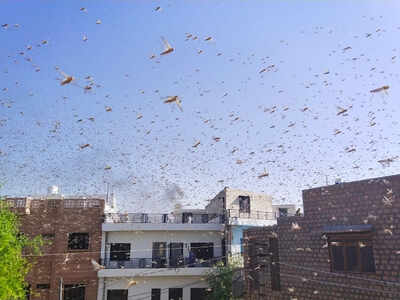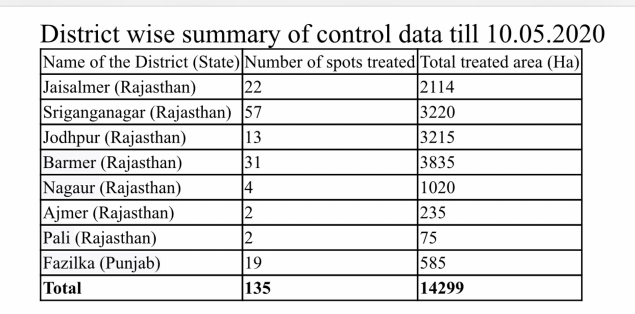Top Searches
- News
- India News
- India steps in to bring Pakistan on board to check locust invasion, drones to be used to spray pesticides
India steps in to bring Pakistan on board to check locust invasion, drones to be used to spray pesticides

NEW DELHI: Staring at possibility of locust invasion of greater magnitude during monsoon, beginning June, the Centre has stepped up India’s preparedness, including initiating surveillance in vulnerable states - Rajasthan, Gujarat, Punjab and Haryana - soon using drones, and taken initiative to open bilateral channel with Pakistan for better coordinated response to deal with the common enemy. Locust invasion has the potential to destroy crops on lakhs of hectares of farm land in both the countries.
At present, locust swarms are active in Barmer, Jodhpur, Nagaur, Sriganganahar and Ajmer districts of Rajasthan.
Though the current attack could not harm much as the harvest of crops in these districts has already been completed, timely action is needed to prevent any damage during the sowing of summer crops.

So state authorities, under direct supervision from Union agriculture ministry, have, so far, already treated over 14,299 hectares of farm land at 135 spots in Jaisalmer, Sri Ganganagar, Jodhpur, Barmer, Nagaur, Ajmer and Pali districts of Rajasthan and Fazilka district of Punjab.
Underlining the prediction from the UN’s Food and Agriculture Organisation (FAO) which hinted at possibility of spurt in locust attack from June, an official said, "The ministry has already initiated locust control exercise and even floated tender to empanel agencies for using drones for surveillance in vulnerable areas."
Asked about coordination with Pakistan like what India did last year when both countries met five times at Munabao in India and Khokhropar in Pakistan, the official said, "The ministry has initiated a process to begin bilateral meeting through FAO and this time it would possibly be a virtual meeting to exchange information on tackling locust attack in current Covid-19 situation."
He said, "Since the locust attack happened this year earlier than its normal invasion period, we want an early bilateral meeting."
It’ll be in addition to the FAO’s ongoing effort to bring four affected countries in Asia - India, Pakistan, Iran and Afghanistan - on the same page for coordinated action. So far, eight virtual meetings have been held among representatives of all four countries on Skype since March 11 when the first high-level meeting was held on the locust invasion issue. India was represented by minister of state for agriculture, Kailash Choudhary, and Union agriculture secretary, Sanjay Agarwal, in the meeting. These multilateral virtual meetings are now held every Monday since then.
On use of drones, the official said, "Besides surveillance, the drones will also be used for aerial spraying of pesticides in India. The Centre is also in the process of procuring additional specialised sprayers (equipped with latest technology) from United Kingdom (UK). Currently, 50 spray equipment/vehicles are being used to control the locust attack. Tractor mounted sprayers and fire-tenders, deployed at various locations, are also being used for locust control operation."
Union agriculture minister, Narendra Singh Tomar, on Wednesday discussed issue of use and availability of pesticides with representatives of private companies and sensitised officials for actions on the ground.
At present, 10 locust circle offices of the central government, located in Jaisalmer, Bikaner, Jodhpur, Barmer, Jalore, Churu, Nagaur, Suratgarh districts of Rajasthan; and Palanpur and Bhuj districts of Gujarat, are working in scheduled desert area of more than 2 lakh sq km in India.
Normally, with the arrival of the monsoon, locust swarms enter the scheduled desert areas of India via Pakistan for breeding in the summer of June/July.
"But this year, presence of locust hoppers was reported from April 11 and pink adult swarms were reported from April 30 in border districts of Rajasthan and Punjab, which have, however, been controlled. Besides, control operations against new swarms are going on," said a statement from agriculture ministry.
It said, "One reason for this was the uncontrolled swarms of the previous season in Pakistan who breed continuously. Swarms of pink immature adults fly high and travel long distances with strong winds coming from Pakistan. Most of these pink immature adults settle on trees during the night and mostly fly during the day."
Globally, 30 countries (mostly African and west Asian) covering 16 million sq km are vulnerable to desert locust attack.
Locusts inflict damage by devouring leaves, flowers, fruits, seeds, bark and growing plants, and also by breaking trees because of their weight when they settle down in masses. An adult desert locust can consume roughly its own weight in fresh food per day.
"One sq km size swarm contains about 40 million locusts, which eat the same amount of food in one day as about 35,000 people, 20 camels or 6 elephants," said an official note on the locust attack during 2019-20.
During 2019-20, there was a massive locust attack in India. Total 4,03,488 hectares of area was treated during control operations from from May 21, 2019 to February 17, 2020.
At present, locust swarms are active in Barmer, Jodhpur, Nagaur, Sriganganahar and Ajmer districts of Rajasthan.
Though the current attack could not harm much as the harvest of crops in these districts has already been completed, timely action is needed to prevent any damage during the sowing of summer crops.

So state authorities, under direct supervision from Union agriculture ministry, have, so far, already treated over 14,299 hectares of farm land at 135 spots in Jaisalmer, Sri Ganganagar, Jodhpur, Barmer, Nagaur, Ajmer and Pali districts of Rajasthan and Fazilka district of Punjab.
Underlining the prediction from the UN’s Food and Agriculture Organisation (FAO) which hinted at possibility of spurt in locust attack from June, an official said, "The ministry has already initiated locust control exercise and even floated tender to empanel agencies for using drones for surveillance in vulnerable areas."
Asked about coordination with Pakistan like what India did last year when both countries met five times at Munabao in India and Khokhropar in Pakistan, the official said, "The ministry has initiated a process to begin bilateral meeting through FAO and this time it would possibly be a virtual meeting to exchange information on tackling locust attack in current Covid-19 situation."
He said, "Since the locust attack happened this year earlier than its normal invasion period, we want an early bilateral meeting."
It’ll be in addition to the FAO’s ongoing effort to bring four affected countries in Asia - India, Pakistan, Iran and Afghanistan - on the same page for coordinated action. So far, eight virtual meetings have been held among representatives of all four countries on Skype since March 11 when the first high-level meeting was held on the locust invasion issue. India was represented by minister of state for agriculture, Kailash Choudhary, and Union agriculture secretary, Sanjay Agarwal, in the meeting. These multilateral virtual meetings are now held every Monday since then.
On use of drones, the official said, "Besides surveillance, the drones will also be used for aerial spraying of pesticides in India. The Centre is also in the process of procuring additional specialised sprayers (equipped with latest technology) from United Kingdom (UK). Currently, 50 spray equipment/vehicles are being used to control the locust attack. Tractor mounted sprayers and fire-tenders, deployed at various locations, are also being used for locust control operation."
Union agriculture minister, Narendra Singh Tomar, on Wednesday discussed issue of use and availability of pesticides with representatives of private companies and sensitised officials for actions on the ground.
At present, 10 locust circle offices of the central government, located in Jaisalmer, Bikaner, Jodhpur, Barmer, Jalore, Churu, Nagaur, Suratgarh districts of Rajasthan; and Palanpur and Bhuj districts of Gujarat, are working in scheduled desert area of more than 2 lakh sq km in India.
Normally, with the arrival of the monsoon, locust swarms enter the scheduled desert areas of India via Pakistan for breeding in the summer of June/July.
"But this year, presence of locust hoppers was reported from April 11 and pink adult swarms were reported from April 30 in border districts of Rajasthan and Punjab, which have, however, been controlled. Besides, control operations against new swarms are going on," said a statement from agriculture ministry.
It said, "One reason for this was the uncontrolled swarms of the previous season in Pakistan who breed continuously. Swarms of pink immature adults fly high and travel long distances with strong winds coming from Pakistan. Most of these pink immature adults settle on trees during the night and mostly fly during the day."
Globally, 30 countries (mostly African and west Asian) covering 16 million sq km are vulnerable to desert locust attack.
Locusts inflict damage by devouring leaves, flowers, fruits, seeds, bark and growing plants, and also by breaking trees because of their weight when they settle down in masses. An adult desert locust can consume roughly its own weight in fresh food per day.
"One sq km size swarm contains about 40 million locusts, which eat the same amount of food in one day as about 35,000 people, 20 camels or 6 elephants," said an official note on the locust attack during 2019-20.
During 2019-20, there was a massive locust attack in India. Total 4,03,488 hectares of area was treated during control operations from from May 21, 2019 to February 17, 2020.
FacebookTwitterLinkedinMail
Start a Conversation
end of article
Trending Topics
Quick Links
Coronavirus in MumbaiCoronavirus in KolkataCoronavirus in HyderabadCoronavirus in DelhiCoronavirus in BangaloreCoronavirus symptomsCoronavirus in IndiaWhat is CoronavirusCoronavirus NewsSolar EclipseNPRWhat is NRCCAB BillCAB and NRCRTI BillPodcast newsLok SabhaShiv SenaYSRCPCongressBJP newsUIDAIIndian ArmyISRO newsSupreme Court